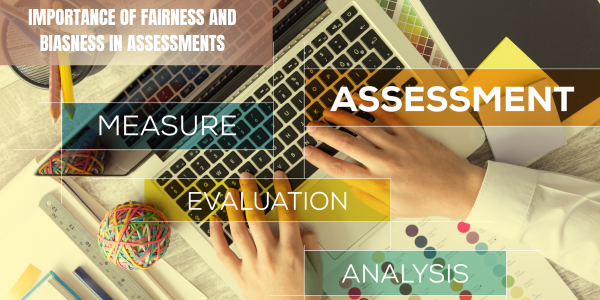 Fairness and biasness are two important considerations in assessments. Here’s a more detailed explanation of each concept:
Fairness and biasness are two important considerations in assessments. Here’s a more detailed explanation of each concept:
Fairness in assessments means that all individuals are given an equal opportunity to demonstrate their skills and knowledge. This means that the assessment should be designed and implemented in a way that is unbiased and free from discrimination. The assessment should measure the skills and knowledge that are relevant to the job or task being assessed. All individuals should be evaluated using the same criteria, and the assessment process should be transparent and objective.
Also Read: How to answer, “What are your Career Aspirations”?
Some ways to ensure fairness in assessments include:
- Ensuring that the assessment is relevant to the job or task being assessed.
- Using standardized assessment procedures and instructions.
- Ensuring that the assessment is administered in the same way to all individuals.
- Ensuring that the assessment is free from any type of discrimination or biasness.
- Providing accommodations for individuals who require them.
Biasness in assessments refers to any factors that can influence the assessment process in a way that is unfair or discriminatory. Biasness can occur at any stage of the assessment process, including the design, administration, and scoring of the assessment.
Some examples of biasness in assessments include:
- Using language that is biased or not inclusive.
- Scoring the assessment subjectively, rather than using objective criteria.
- Allowing personal biases or stereotypes to influence the assessment process.
- Not providing accommodations for individuals who require them.
- Using assessments that are not relevant to the job or task being assessed.
Also Read: What is Career Planning & how to do it?
To reduce the risk of biasness in assessments, it is important to use standardized procedures, objective criteria, and inclusive language. It is also important to review the assessment process regularly to ensure that it remains fair and effective for all individuals.
Fairness and biasness are crucial aspects of any assessment process, including hiring assessments, performance evaluations, and educational assessments. The importance of fairness and biasness in assessments lies in the need to ensure that all individuals are evaluated on the same criteria and that there are no undue advantages or disadvantages based on irrelevant factors such as gender, race, ethnicity, or socioeconomic status.
Fairness in assessments refers to the degree to which the assessment process is unbiased, consistent, and relevant to the skills and abilities required for the job or task. A fair assessment process provides equal opportunities for all individuals to demonstrate their skills and abilities, regardless of their background or identity.
Biasness in assessments, on the other hand, refers to the tendency to favor or disadvantage certain individuals or groups based on irrelevant factors. Biasness can occur at any stage of the assessment process, from the design of the assessment to the scoring and interpretation of the results. For example, biasness can occur if the assessment contains language that is not inclusive or if the assessment is scored subjectively without clear criteria.
Unfair or biased assessments can have serious consequences, including discrimination, lack of diversity in the workplace, and decreased employee morale and productivity. Therefore, it is important to design and implement assessments that are fair and unbiased, by using standardized procedures, objective criteria, and inclusive language. It is also important to review the assessment process regularly to ensure that it continues to be fair and effective for all individuals.
This is one of the major problems that most job seekers face. They are usually eliminated either on the basis of their background, class 12th percentage, graduation percentage, etc but not on the basis of their potential. This is where biasness comes in, and deserving candidates miss out on their chances of getting the job just because of the above-mentioned factors.
It’s time when companies must change their perspective and must assess a candidate on the basis of correct parameters such as potential, knowledge, and scores of the assessment. These days most preferred tool for the same is AMCAT. It is used by most of the companies, to avoid any sort of biasness since the questions for the assessment are created by experts, they will not be found anywhere on the internet. This helps in maintaining the newness especially because the questions are shuffled time to time. This is one of the important aspects, which is kept in mind while creating questions since corporates are very concerned about freshness. Not just this, AMCAT provides a digital scorecard that is based on scores and is unbiased. This can help recruiters to make a decision on the basis of scores.
Also Read: College Student Resume Example and 6 Tips For 2023
FAQs
Q1: What is fairness in assessments?
Ans: Fairness in assessments refers to the extent to which the assessment is free from biasness and provides an equal opportunity for all individuals to demonstrate their knowledge, skills, and abilities.
Q2: What is biasness in assessments?
Ans: Biasness in assessments refers to any systematic error or distortion in the assessment process that can affect the scores or ratings of certain groups of individuals based on factors such as their race, gender, ethnicity, or socioeconomic status.
Q3: Why is fairness important in assessments?
Ans: Fairness is important in assessments because it ensures that all individuals are given an equal opportunity to demonstrate their knowledge, skills, and abilities, regardless of their background or characteristics. This is essential for promoting meritocracy and equity in education and employment.
Q4: How can biasness in assessments be reduced?
Ans: Biasness in assessments can be reduced by ensuring that the assessment content and procedures are fair and valid, minimizing the influence of extraneous factors such as stereotypes, and using multiple measures and diverse perspectives to evaluate individuals.
Q5: What are some common types of biasness in assessments?
Ans: Some common types of biasness in assessments include cultural, gender, linguistic, and stereotype biasness.
Q6: What are some strategies for promoting fairness in assessments?
Ans: Some strategies for promoting fairness in assessments include using diverse assessment methods, providing accommodations for individuals with disabilities, providing clear instructions and feedback, and using objective and reliable scoring criteria.
{
“@context”: “https://schema.org”,
“@type”: “FAQPage”,
“mainEntity”: [{
“@type”: “Question”,
“name”: “What is fairness in assessments?”,
“acceptedAnswer”: {
“@type”: “Answer”,
“text”: “Fairness in assessments refers to the extent to which the assessment is free from biasness and provides an equal opportunity for all individuals to demonstrate their knowledge, skills, and abilities.”
}
},{
“@type”: “Question”,
“name”: “What is biasness in assessments?”,
“acceptedAnswer”: {
“@type”: “Answer”,
“text”: “Biasness in assessments refers to any systematic error or distortion in the assessment process that can affect the scores or ratings of certain groups of individuals based on factors such as their race, gender, ethnicity, or socioeconomic status.”
}
},{
“@type”: “Question”,
“name”: “Why is fairness important in assessments?”,
“acceptedAnswer”: {
“@type”: “Answer”,
“text”: “Fairness is important in assessments because it ensures that all individuals are given an equal opportunity to demonstrate their knowledge, skills, and abilities, regardless of their background or characteristics. This is essential for promoting meritocracy and equity in education and employment.”
}
},{
“@type”: “Question”,
“name”: “How can biasness in assessments be reduced?”,
“acceptedAnswer”: {
“@type”: “Answer”,
“text”: “Biasness in assessments can be reduced by ensuring that the assessment content and procedures are fair and valid, minimizing the influence of extraneous factors such as stereotypes, and using multiple measures and diverse perspectives to evaluate individuals.”
}
},{
“@type”: “Question”,
“name”: “What are some common types of biasness in assessments?”,
“acceptedAnswer”: {
“@type”: “Answer”,
“text”: “Some common types of biasness in assessments include cultural, gender, linguistic, and stereotype biasness.”
}
},{
“@type”: “Question”,
“name”: “What are some strategies for promoting fairness in assessments?”,
“acceptedAnswer”: {
“@type”: “Answer”,
“text”: “Some strategies for promoting fairness in assessments include using diverse assessment methods, providing accommodations for individuals with disabilities, providing clear instructions and feedback, and using objective and reliable scoring criteria.”
}
}]
}

























